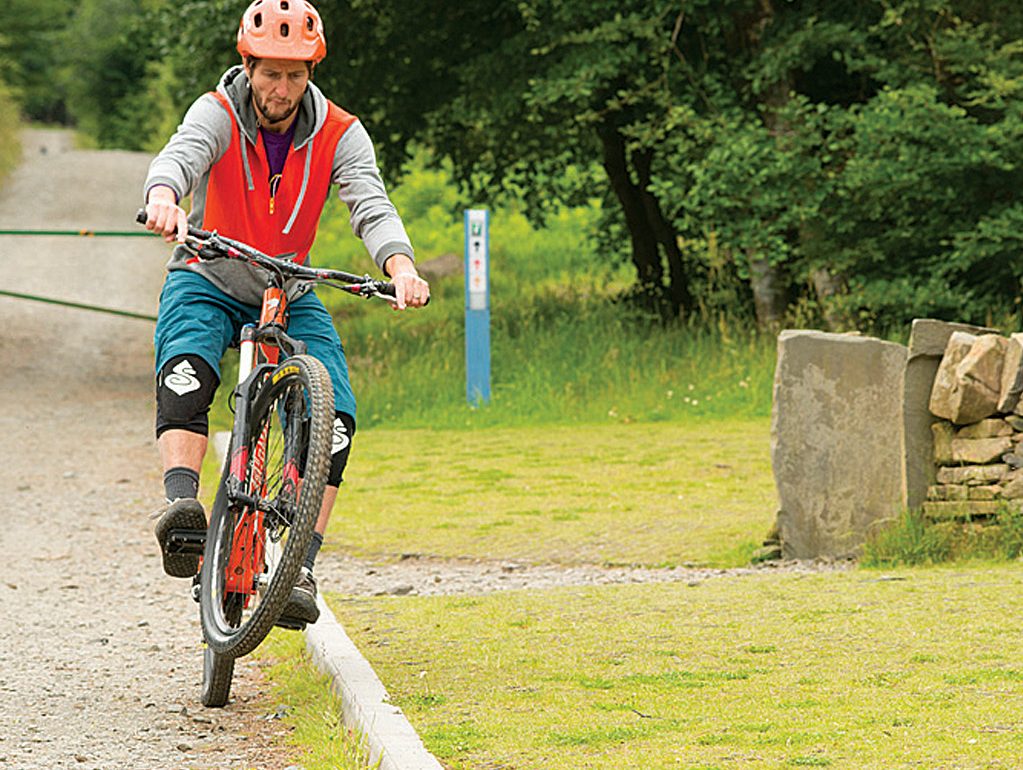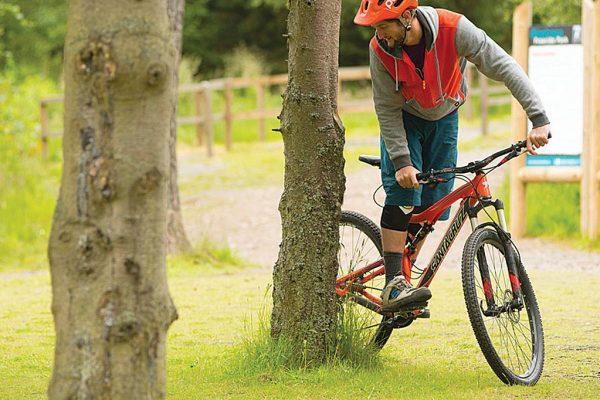MTB skills you can practise anywhere
If you’re not supposed to be out mixing with the general public at the moment, you can still go for a ride. If you have a back garden anyway.
>>> MBR and COVID-19: a word from the editor
Try these activities for starters…

Wheelie
The humble wheelie, beloved of teenagers and victorious XC racer. The ability to lift your front wheel at low speed is actually vital for getting up and over trail obstacles.
Forget the distance you hold the wheelie for and concentrate on the balance and timing of the lift. Keep your bum in the saddle, make sure your arms, handlebars and shoulders form a square, choose a gear that provides some resistance but isn’t too hard, and place a finger over the rear brake lever.
Now lean back from your shoulders while you push on the pedals. Your arms should remain straight and your hips fixed in the saddle, allowing the lift to be 100 per cent body weight and almost zero per cent strength. Let the lift come from your upper body pivoting around the rear axle while your pedalling causes the rear wheel to move forwards below you.

Track stand
The simple skill of standing upright and pausing while staying composed actually underpins most technical climbs. The ability to stay upright with your feet on the pedals will buy you valuable time in numerous situations.
Roll to a stop, turn your front wheel to your preferred side and stand upright. Hold the bike still by using tension through the chain, not by pulling the brakes. A gentle rocking motion forward and backwards will allow you to fine-tune your balance, and straight arms and an upright back will give you a platform from which you can roll your hands on the bars in all axes. The big mistake is to crouch with bent elbows or knees. Get your limbs straight and keep your head up.

Slow speed turn
Find an object and see how slowly you can turn around it. Make sure you remain composed, learn to use your body and bike individually, and if you’re wobbling around, straying off line or putting a foot down, then persevere.
It’ll feel awkward but, unlike faster corners where leaning gets you around the bend, turn your handlebars to steer. Get used to using the momentum of the bike and how your upper and lower body movements affect your balance. You should learn, over time, how to regain balance and when it’s right to move your shoulders and when to move your feet, legs or hips. Making, then correcting, these mistakes is the best way to learn.

Manual
Imagine someone has tied a rope around your waist and is trying to pull you off the back of your bike as you ride past. This would replicate a manual. Start standing up, rock forwards if you’re going slowly to initiate some momentum, move back quickly from the hips and let your arms straighten as you go back. Your head shouldn’t lift and you should use as much room behind the saddle as you can.
As your hips start to pass beyond the saddle, dip your heels and straighten your knees, helping to push the bike forwards. The reliance on your lower body will keep your centre of gravity low, perfect for high-speed and technical trail situations. Just like the wheelie, make sure your arms, handlebars and shoulders are forming a square.
Once in position over the rear wheel, hand responsibility over to your legs. Keeping your upper body in the same position, straighten and bend your knees to maintain your balance point. Cover your rear brake in case you’re overbalancing.

Side hop
To get some sideways movement into your hop, use your arms and shoulders to twist and turn sideways while the front wheel is lifting. You’ll need to add the turn in throughout the first phase of your bunny hop, meaning you’ll be moving up and sideways at the same time.
The most common mistake is to force a sideways movement in after your hop is done, or even before it’s started. With your arms moving up and sideways, let your hips follow the same path to lift the rear wheel. Remember, you should be taking off front wheel first and landing front wheel first or with both wheels at the same time. There should be very little resistance throughout the whole move; instead your upwards arch and sideways shift should be linked at every stage of the movement.

Plank balance
Slow speed control is something you’ll use all the time, whether balanced on some wooden ‘North Shore’ monstrosity, trying to ride a narrow passage, or taking on a technical climb. Set yourself a challenge: how far can you get along a plank? How slowly can you do it?
To be successful, you’ll need to keep either your bike or body upright, never allowing both to waver sideways at the same time. This coordinated yet individual movement of the bike and body is a key skill to practise and one many riders don’t have. Let your shoulders, hips, hands, arms and legs move side to side with your bike but never your head. Keep looking along the line finding an imaginary point a few metres ahead of your front wheel.
Our position on cycling during coronavirus crisis
- The government has advised on the importance of exercise, and the options are limited while taking into account the need to reduce social contact. Therefore cycling is a good way for people to stay healthy at this stage of the crisis.
- The stress of the current situation and the demands of social distancing will put additional strain on individuals’ mental well-being, and cycling is known to be beneficial in this regard.
- Cyclists should adhere to the guidelines in place, including respecting social distancing and avoiding cafes/restaurants. Therefore they should be self-sufficient in terms of food, drink and tools to fix common roadside problems. They should also carry tissues, and dispose of them properly after their ride.
- Cycling is not inherently dangerous, but riders should still be especially careful on the roads. This isn’t the time to try to set KOMs on descents – ride sensibly for fitness and happiness, not for white-knuckle thrills.
- The above only covers the general populace who are being asked to limit social contact. Anyone who needs to self-isolate – for example if they or someone they live with is showing symptoms – should not be cycling.
Thanks to
Dirt School’s free coaching app lets you see the right and wrong techniques in slo-mo.
Download it for free here: Google Play | iTunes Apps
Words by: Chris Ball is a Scottish downhill star, UCI DH technical delegate and the man behind MTB skill school, dirtschool.co.uk




